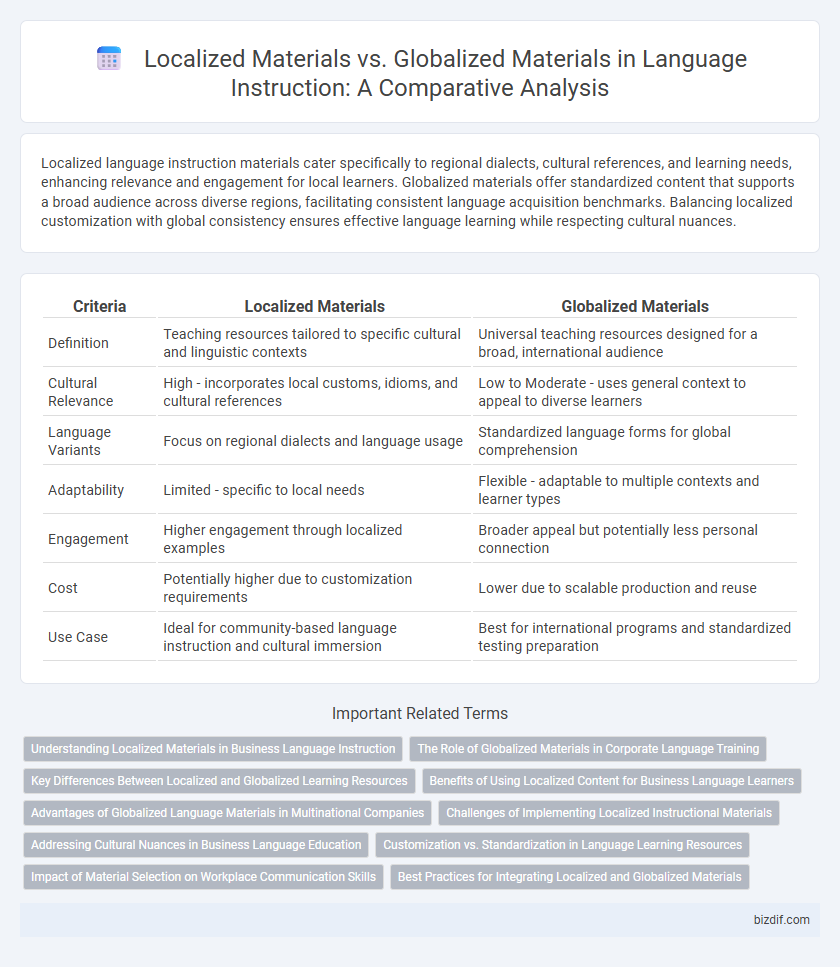Localized language instruction materials cater specifically to regional dialects, cultural references, and learning needs, enhancing relevance and engagement for local learners. Globalized materials offer standardized content that supports a broad audience across diverse regions, facilitating consistent language acquisition benchmarks. Balancing localized customization with global consistency ensures effective language learning while respecting cultural nuances.
Table of Comparison
| Criteria | Localized Materials | Globalized Materials |
|---|---|---|
| Definition | Teaching resources tailored to specific cultural and linguistic contexts | Universal teaching resources designed for a broad, international audience |
| Cultural Relevance | High - incorporates local customs, idioms, and cultural references | Low to Moderate - uses general context to appeal to diverse learners |
| Language Variants | Focus on regional dialects and language usage | Standardized language forms for global comprehension |
| Adaptability | Limited - specific to local needs | Flexible - adaptable to multiple contexts and learner types |
| Engagement | Higher engagement through localized examples | Broader appeal but potentially less personal connection |
| Cost | Potentially higher due to customization requirements | Lower due to scalable production and reuse |
| Use Case | Ideal for community-based language instruction and cultural immersion | Best for international programs and standardized testing preparation |
Understanding Localized Materials in Business Language Instruction
Localized materials in business language instruction enhance learner engagement by incorporating culturally relevant examples, idioms, and industry-specific scenarios tailored to the target region. These resources improve comprehension and practical application by addressing local business practices, communication styles, and regulatory environments. Focusing on localized content ensures that language learners develop skills that are directly applicable and effective within their specific business contexts.
The Role of Globalized Materials in Corporate Language Training
Globalized materials in corporate language training offer standardized content that ensures consistency across multinational teams, facilitating unified communication and brand representation. These materials incorporate widely recognized business terminology and culturally neutral examples, allowing employees from diverse backgrounds to engage effectively. Leveraging globalized resources accelerates onboarding and supports scalable language proficiency development in global enterprises.
Key Differences Between Localized and Globalized Learning Resources
Localized learning materials incorporate cultural relevance, language nuances, and region-specific examples, enhancing learner engagement and comprehension in a particular context. Globalized materials emphasize universal concepts and standardized language, ensuring consistency and scalability across diverse populations. The key difference lies in the tailored adaptation to local customs and idiomatic expressions versus broad applicability and uniformity in globalized resources.
Benefits of Using Localized Content for Business Language Learners
Localized language learning materials enhance comprehension and cultural relevance, enabling business language learners to better understand industry-specific terminology and local business customs. Tailored content increases learner engagement by reflecting real-world scenarios encountered in local markets, improving practical communication skills. This targeted approach fosters more effective negotiation, collaboration, and relationship-building in multicultural business environments.
Advantages of Globalized Language Materials in Multinational Companies
Globalized language materials in multinational companies promote consistent communication standards and facilitate collaboration across diverse cultural and geographic locations. These materials streamline training processes by providing uniform content, reducing costs associated with customization and translation. Access to globalized resources enhances employees' intercultural competence, supporting smoother integration in international teams and fostering a cohesive corporate culture.
Challenges of Implementing Localized Instructional Materials
Implementing localized instructional materials presents challenges such as the need for extensive cultural adaptation to ensure relevance and engagement for diverse learner populations. Limited resources and expertise in local dialects or cultural nuances often hinder the development and validation of effective localized content. Balancing linguistic accuracy with culturally appropriate pedagogy requires continuous collaboration between educators, linguists, and community stakeholders.
Addressing Cultural Nuances in Business Language Education
Localized materials in business language education enhance comprehension by incorporating region-specific terminology, customs, and communication styles, which reflect the cultural nuances critical for effective interactions. Globalized materials offer standardized content suitable for diverse audiences but may overlook subtle cultural differences that impact business etiquette and negotiation tactics. Tailoring language instruction with localized content supports learners in developing culturally appropriate communication skills essential for successful international business engagements.
Customization vs. Standardization in Language Learning Resources
Localized materials in language instruction emphasize customization by tailoring content to reflect cultural nuances, regional dialects, and specific learner needs, enhancing relevance and engagement. Globalized materials prioritize standardization, offering uniform content designed for broad applicability across diverse learners, ensuring consistency and ease of distribution. Effective language learning resources balance customization with standardization to optimize accessibility while maintaining cultural resonance.
Impact of Material Selection on Workplace Communication Skills
Localized materials enhance workplace communication skills by aligning language instruction with cultural nuances and industry-specific terminology, leading to more effective and contextually relevant interactions. Globalized materials provide standardized language frameworks that promote consistency and facilitate communication across diverse international teams. Selecting appropriate materials based on the workplace context directly influences the clarity, efficiency, and professionalism of employee communication.
Best Practices for Integrating Localized and Globalized Materials
Effective language instruction incorporates a strategic blend of localized and globalized materials to achieve cultural relevance and broad comprehension. Utilizing localized content enhances learners' engagement by reflecting their immediate environment and sociocultural norms, while globalized materials expose students to diverse linguistic contexts and international standards. Best practices include aligning materials with specific learning objectives, incorporating culturally responsive pedagogy, and continuously assessing the balance to optimize language acquisition and cross-cultural communication skills.
Localized materials vs Globalized materials Infographic

 bizdif.com
bizdif.com